subdue - To make less intense.
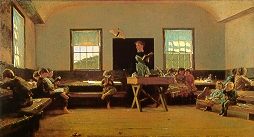 subject - That which is represented
in an artwork. For example,
a nineteenth century rural American classroom is the subject in
the painting by Winslow Homer
(American, 1836-1910) of
subject - That which is represented
in an artwork. For example,
a nineteenth century rural American classroom is the subject in
the painting by Winslow Homer
(American, 1836-1910) of The
Country School, 1871,
oil on canvas,
Saint Louis Art Museum. The subject of a work is one of its literal qualities.
Quote:
Related link:
Also see allegory, content, genre, iconography, iconology, interpretation, taxis, and theme.
subjectivity - Whenever conclusions are considered or reached which depend upon ideas existing within a person's mind; taking a personal point of view; personal. Quality of perceptions existing only within the experiencer's mind, but not necessarily in reality. Expression of the individuality of an artist or author.
Quote:
Also see content, context, interesting, meaning, and objectivity.
sublime - A concept, thing or state of exceptional and awe-inspiring beauty and moral or intellectual expression — a goal to which many nineteenth-century artists aspired in their artworks. Noble, majestic. Also see aesthetics, chado, cute, harmony, Hudson River School, Impressionism, kitsch, landscape, Luminism, mystery, nature, nice, pain, picturesque, positive, pretty, Realism, Romanticism, and Stendhal syndrome.
subliminal message or subliminal advertising - Flashing a message — sometimes a graphic image, but usually a short text — in one frame of a film or video. Played at full speed, such a message is barely perceived, particularly if the viewer isn't looking for it. The theory is that even though a viewer will not be consciously aware of the message, it will make an impression on the viewer's subconscious. In 1974, the U.S. government's Federal Communications Commission (FCC) ruled that subliminal advertising was contrary to the public interest. Bill Benoit, who studies political advertising at the University of Missouri, has said that subliminal messages aren't necessarily effective. "There's no conclusive evidence that it works," he said. "Of course, that doesn't stop advertisers." The term is sometimes also used to describe softsell or indirect advertising, or to the expectation that such subtle factors as costume, scenery, or ethnicity might influence the thinking of a viewer.
An example of a subliminal message in advertising:

A U.S. presidential campaign television commercial
made by Alex Castellanos, and broadcast in September of 2000,
included a frame flashing the word "RATS" across the
screen. The advertisement touted Bush's plan for adding prescription
drugs to Medicare, arguing that senior citizens will have more
control over their health care under Bush's proposal. Gore's
plan, the ad said, will be run by bureaucrats. Words appear on
the screen to echo the announcer's message: "The Gore prescription
plan: Bureaucrats decide." But just as the
 announcer
says "bureaucrats decide," the word "RATS,"
in large, white capital letters, fills the black screen. This
ad was pulled off the air amid allegations that candidate George
W. Bush's supporters were trying to send a subliminal message
about his opponent, Al Gore. Bush maintained the placement of
the message was "not intentional." Outside analysts
said they found it hard to believe the word was not deliberately
placed. "The word 'RATS' is so carefully superimposed. It's
not like it just randomly appears on the screen," said Darrell
West, an expert on political advertising at Brown University.
announcer
says "bureaucrats decide," the word "RATS,"
in large, white capital letters, fills the black screen. This
ad was pulled off the air amid allegations that candidate George
W. Bush's supporters were trying to send a subliminal message
about his opponent, Al Gore. Bush maintained the placement of
the message was "not intentional." Outside analysts
said they found it hard to believe the word was not deliberately
placed. "The word 'RATS' is so carefully superimposed. It's
not like it just randomly appears on the screen," said Darrell
West, an expert on political advertising at Brown University.
Also see afterimage, déjà vu, fluorescent colors, gestalt, interesting, knowledge, memory, miserable failure, propaganda, resonance, seeing, and unconscious.
subsampling - Using an algorithm to derive a lower-resolution digital image from a higher resolution image; for example, eliminating every third pixel in every direction. This selective elimination is actually called "decimation."
Related link:
Also see thumbnail.

subtraction, subtractive - Subtraction is the act of removing. In art, an action is subtractive when it produces subtraction, as of some materials in carving, for example. Materials especially appropriate for subtractive sculpture in schools include clay, chalk, plaster, soft salt blocks, artificial sandstone, soap, and wax. The mixing of pigments is also called subtractive color mixing (as opposed to the additive mixing of incident light to achieve additive color mixing). The subtractive primary colors are cyan, yellow, and magenta.
Also see angle of incidence, assemblage sculpture, blot, construction, dent, detritus, erasure, light, manipulate, modeling, primary colors, secondary colors, and solvent.
success - The achievement of something attempted. And a person who succeeds. Success is relative and temporary, but the attainment of success is among the most satisfying experiences. An artist can experience success frequently and deeply — seeing the growth of his / her artistic abilities and accomplishments, the exhibition and discussion of the work by an interested audience, prosperity from demand for the work, and hope that posterity will value it too.
Quotes:
Also see art criticism, assessment, effort, evaluation, fame, flourish, game theory, goal, inspiration, masterpiece, motivation, praise, quality, standards, talent, and time.
suffuse - Gradually spreading over the surface and serving to color or tint, as with a fluid or a gleam of light.
Example:
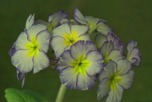
This photograph of flowers is suffused with
a yellow-green light, as if a colored
filter had been used.
Also see Luminism and monochromatic.
Sui - A Chinese dynasty that lasted 581 - 618.
Examples of work of this period:
China, Figurine of Attendant Official with Black Decoration, 595 CE ("15th year of Kaihuang's reign of the Sui Dynasty"), porcelain, height 72 cm, Henan Museum, China. Unearthed at Anyang, Henan. When the tomb of Zhang Sheng was excavated in 1959, over 90 pieces of porcelain were found.
China, White-glazed porcelain Weiqi chessboard, 595 CE ("15th year of Kaihuang's reign of the Sui Dynasty"), height 4 cm, Henan Museum, China. Unearthed at Anyang, Henan. This white-glazed go board unearthed from the tomb of Zhang Sheng has 19 vertical stripes and 19 horizontal stripes, forming 361 intersecting points. It is the earliest example of a weiqi go board with 19 stripes discovered in China so far.
suiseki - A Japanese word (from the Japanese characters for water "sui" and stone "seki") for a stone shaped by natural erosion. The Chinese, influenced by Taoism, originated the concept, and use their own terms, calling their stones "scholars' rocks." Some in the West refer to suiseki as "viewing stones." Suiseki is the study and enjoyment of such stones as objects of beauty. The term can refer either to the study of these stones or to the stones themselves — displayed and enjoyed in interiors, and prized as objects sitting at the boundary between art and nature. One of the key ingredients of a suiseki stone is its likeness to an object or to a landscape. To be considered a suiseki a stone's shape must be clean, it must be pleasing to the viewer, and it must stir the viewer's emotions. Suiseki typically convey a likeness either to an object or to a landscape, but are occasionally simply abstract in form.
(pr. sə-EE-sə-kə)
Examples:
![]()
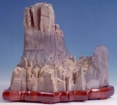
![]()
Shear Cliffs, natural stone on wooden base.
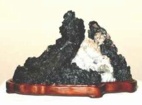
Glacier Between Mountain Peaks, natural stone on wooden base.
Also see aleatory and aleatoric, bonsai, Japanese art, wabi-sabi, and Zen.
suki - In Japanese art, an aesthetic quality; artlessness.
Also see wabi-sabi.
Sumerian art - See Mesopotamian art.
sumi-e - In Japanese art, painting in monochromatic ink.
Also see genpitsu and tradition.
Sung - A Chinese dynasty that lasted 960 - 1279, also called the Song dynasty. It can be subdivided into the Northern Sung Dynasty (960 - 1127) and the Southern Sung dynasty (1127 - 1279).
Examples of work of this Sung dynasty period:
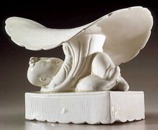
China, Northern Sung Dynasty, Pillow in the form of a boy and a lotus leaf,
c. 1000-1200, ding ware, porcelain
with incised decoration,
Asian Art Museum, San Francisco, CA.

China, Xinjiang, Square, 1050-1250, Sung dynasty, silk,
on silk, 14 5/8 x 14 7/8 inches (37.15 x 37.78 cm), Metropolitan
Museum of Art, NY.

Mi Fu (Chinese, 1052-1107), Poem Written in a Boat on the Wu River,
Northern Sung dynasty (960-1127), c. 1100, handscroll, ink
on paper, 12 1/4 inches x 18 feet
3 1/4 inches (31.1 x 557 cm), Metropolitan Museum of Art, NY.
See calligraphy
and scroll.

China, Vase with tubular ears, Southern Sung
dynasty, Kuan ware, celadon
glazed porcelain,
National Palace Museum, Taipei.

China, Southern Sung dynasty (1127-1279),
Tea bowl stand, brown lacquer
on wood and fabric, Asian Art Museum,
San Francisco, CA.
superficial - Being on or near the surface; lacking in depth or thoroughness. Shallow; concerned with or understanding only what is apparent or obvious. Apparent rather than actual or substantial. Insignificant; trivial.
Example:
![]()

![]()
This image illustrates the superficial musculature,
various glands and nerves of the head and neck.
Also see bad art.
Superrealism - Another name for photorealism.

suppedaneum - A support for the feet of a crucified person, projecting from the foot of the vertical shaft of the cross. This can be seen on a typical crucifix.
support - The material providing a surface upon which an artist applies color, collage, etc. Also, holding up, as a base or column often does.
Related link:
Also see armature, buttress, canvas, lattice, leather, linen, panel, paper, parchment, pedestal, pier, plaque, plaster, screen, scroll, structure, stucco, vellum, and watermark.
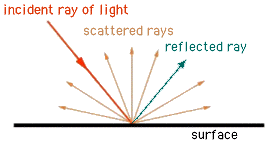 surface
- The outer or topmost boundary or layer of an object.
Colors on any
surface are determined by how incident
rays of light strike it, and how a surface reflects,
scatters, and absorbs those
rays. The material
qualities of a surface, as
well as its form and texture
further determine how it is seen and felt.
surface
- The outer or topmost boundary or layer of an object.
Colors on any
surface are determined by how incident
rays of light strike it, and how a surface reflects,
scatters, and absorbs those
rays. The material
qualities of a surface, as
well as its form and texture
further determine how it is seen and felt.
Quote:
Also see aerial perspective, angle, cleansing, coat, coated paper, curve, découpage, emboss, edge, finish, fluted, fold, glossy, haptic, mark, mat, mirror, moiré, opaque, pleat, repoussé, rugosity, semi-gloss, stain, stain removal, superficial, support, tangent, translucent, transparent, ultraviolet, value, and wireframe.
![]()

surform - A metal abrasive tool fitted with a replaceable blade. As a wood plane is comparable to a shaving razor, a surform is much like a food grater. It allows small particles of material to pass through it without clogging its cutting teeth. Although only one model is shown here (in two positions), surforms are available in a number of sizes and shapes — flat and curved.
Also see carve, file, gouge, plaster, rasp, and riffler.
surimono - In Japanese tradition, a presentation print on special paper and elaborately printed.
Also see ukiyo-e and urushi-e.
surrogate image - A representation, usually in photographic form, used for study.
suyari - In Japanese art, a convention in which clouds are represented in band-like form.

swatch - A manufacturer's sample of a range of cloths, fabrics, paper, or other material. Here is a set of swatches representing colors in which sheets of this material are available.
Also see colorways and textile.
sybaritic - Sensuous; devoted to or marked by excessive luxury. Of or relating to the people of Sybaris, an ancient Greek colony in southern Italy. Such people are sometimes called sybarites as well as Sybarites. Noted for its wealth and luxury, Sybaris was destroyed in warfare in 510 BCE.
(pr. SI-bə-RI-tək)
Also see aestheticism, erotica and erotic art, fin de siècle, obscenity, pornography, sensuality, and voyeurism.
syllogism - An argument claimed in the form of propositions called the premises, with a final proposition called the conclusion, resulting necessarily from the premises. Reasoning from the general to the specific; deduction.
(pr. SI-lə-jizm)
symmetry or symmetrical balance - The parts of an image or object organized so that one side duplicates, or mirrors, the other. Also known as formal balance, its opposite is asymmetry — asymmetrical balance.
Symmetry is among the ten classes of patterns.
Examples:
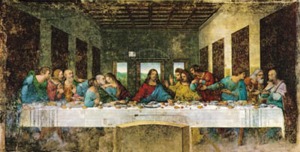
Leonardo da Vinci (Italian, 1452-1519), The Last Supper, 1498, modified fresco, 15 x 29 feet (460 x 880 cm), Convent
of Santa Maria delle Grazie (Refectory), Milan. The overall setting
is highly symmetrically balanced, its focal
point the centrally placed figure
of Christ. This is further balanced by the placement
of six apostles to each side of Christ, even though each man's
appearance is highly individualized.
See cenacole and cenacolo
and Renaissance.

American, 19th Century, Cutout of Animals, second quarter 19th
century, cut paper and watercolor,
18 3/4 x 23 3/4 inches (47.7 x 60.4 cm).

Georgia O'Keeffe (American, 1887-1986), Red, White, and Blue, 1931, oil
on canvas, 39 7/8 x 35 7/8
inches (101.3 x 91.1 cm), Metropolitan Museum of Art, NY.

Roy Lichtenstein (American, 1923-1997), Wall Explosion II, 1965, enamel on steel
relief, 170.2 x 188.0 x 10.2 cm,
110 kg, Tate Gallery, London. Lichtenstein's cartoon-style
explosion displays a type of balance
called radial symmetry. See
Pop Art.
Symmetry and asymmetry two
kinds of balance, which is a principle
of design.
Also see inkblot.
synaesthesia - See the alternative spelling: synesthesia.
Synchromism - A style of painting employing pure colors in harmonious abstract arrangement, was developed by painters Morgan Russell (American, 1886-1953) and Stanton MacDonald-Wright (American, 1890-1973), and first exhibited in Paris in 1913, then at the Armory Show in 1914.
Examples:
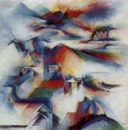
Stanton MacDonald-Wright (American, 1890-1973),
Canon
Synchromy (Orange), 1919, oil
on canvas, 24 1/8 x 24 1/8
inches, Frederick R. Weisman Art Museum, U. of Minnesota.

Stanton MacDonald-Wright, Introspection, 1963-64, oil
on canvas, 60 x 35 inches,
Kemper Museum of Contemporary Art, Kansas City, MO.
This style was similar to that of Orphism.
Also see New Deal art.
syncretism - The merging or fusion of differing philosophies, as in opposing art movement, especially when the result is either incomplete or incongruous.
Also see synergy, synthesis, transformation, and universal artwork.
synergy - The interaction of two or more agents or forces so that their combined effect is greater than the sum of their individual effects.
Also see fusion, syncretism, synergy, synthesis, transformation, and universal artwork.
synesthesia or synaesthesia, and synesthete or synaesthete - A concomitant sensation; a subjective sensation or image of a sense (as of color) other than the one (as of sound) being stimulated. The American Synesthesia Association (ASA) defines it this way:
"Synaesthesia is the general name for a related set (a 'complex') of various cognitive states having in common that stimuli to one sense, such as smell, are involuntarily simultaneously perceived as if by one or more other senses, such as sight or/and hearing. The most common type of 'conceptual' synaesthesia is 'colored graphemes' -- synaesthetically colored letters and numbers. The most common type of 'sensorial' synaesthesia is 'colored hearing', particularly for music."
A synesthete is a person who experiences synesthesia. Wassily Kandinsky (Russian, 1866-1944), who is often credited with producing the first entirely abstract paintings, was a synaesthete. His series of ten Compositions were influenced by his synaesthetic experiences of music and the visual qualities he sensed in listening to it. Kandinsky discovered his synesthesia while attending a Moscow performance of Richard Wagner's opera Lohengrin:
"The violins, the deep tones of the
basses, and especially the wind instruments at that time embodied
for me all the power of that pre-nocturnal hour. I saw all my
colors in my mind; they stood before my eyes. Wild, almost crazy
lines were sketched in front of me."
Wassily Kandinsky, Concerning the Spiritual in Art, 1913
/ 1982, p. 364. See abstraction,
Bauhaus, and
Die Brücke.
The American Synaesthesia Association lists a number of other synesthetes; among them the painter and photographer David Hockney (English, lives and works in USA, 1937-). Some of their works can be seen on the ASA's site. The ASA calls painters Wassily Kandinsky and Georgia O'Keefe (American, 1887-1986; see abstraction and nature) "pseudo-synaesthetes," because it believes these artists theorized their visual counterparts to music rather than experiencing them without effort.
(pr. SI-nəs-THEE-zhə)
Also see cognitive, haptic, lettering, music, simulate, and universal artwork.
synoptic - Presenting a summary, comprehensive or encyclopedic selection of the principal parts of a whole. May be used to refer to a collection of art, for instance — one comprised of works representing all periods, regions, movements, subjects, media, techniques, etc.
Also see museum.
syntax - A systematic, orderly arrangements. This usually refers to the pattern of elements in sentence structure, and the rules that govern them.
(pr. SIN-tax)
Also see principles of design.
synthesis - The forming of a new and coherent whole by combining separate parts; and the ability to do so. Or, the complex whole formed this way. Synthesis represents the fifth level of learning outcomes in the cognitive domain — the level of understanding just beyond application and analysis. Synthesis may involve the production of a unique communication (work of fine art, writing, or music), a plan of operations (research proposal), or set of abstract relations (scheme for classifying information). Learning outcomes in this area stress creative behaviors, with major emphasis on the formulation of new pattern or structures. Objectives of lessons which will increase a student's ability to synthesize can be stated with such behavioral terms as: assemble, blend, build, categorize, create, combine, compile, compose, construct, constitute, conceive, deconstruct, design, develop, devise, effect, evolve, explain, form, formulate, generate, invent, make up, model, modify, originate, plan, produce, rearrange, reconstruct, reorder, reorganize, revise, rewrite, structure, summarize, tell, and transform. The next higher thinking skill is evaluation.
(pr. SIN-thə-sis)
Also see Bloom's Taxonomy, fusion, incongruity, interdisciplinary, original, simulation, syncretism, synergy, transformation, unity, and universal artwork.
synthesis of the arts - See universal artwork.
synthetic - Produced by synthesis. Artificial; not of natural origin.
(pr. sin-THE-tək)
Also see Cubism, ersatz, fiber, nature, plastic, polymer, and resin.
Synthetic Cubism - See Cubism.
https://inform.quest/_art